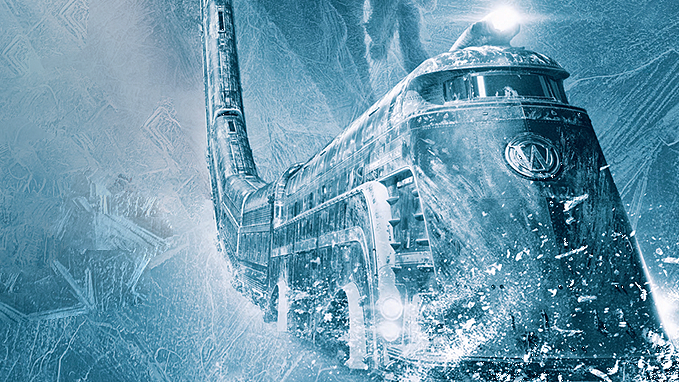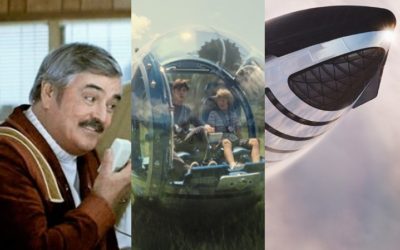Snowpiercer, which began life as a French graphic novel series that started in 1982 and was adapted into a 2013 movie, and is now a series on TNT is many things: a climate-change warning, social commentary about class and inequality, an adventure-survival story, a locked-room murder mystery of a sort, and probably a few more. Oh, and it’s lead is Daveed Diggs who played the Marquis de Layfayette and Thomas Jefferson in Hamilton…so there’s that, too. Here he’s Andre Layton, former (pre-freeze) police and thus the only detective on the train who’s called on to solve a murder.
The television series recently wrapped its first season with a heck of a reveal and had (pre-pandemic) announced and began production on a second season.
The setup sounds nuts: Snowpiercer is the story of the last (okay – perhaps, we don’t know for sure, but no spoilers) 3,000 people on a frozen earth. The earth is frozen due to a failed geoengineering attempt to cool the planet by injecting particulates into the upper atmosphere. It went too well, and the, well…from Diggs’ narration during the first episode’s opening moments:
“First, the weather changed. The deniers knew why, but they doomed us with their lies. War made the earth even hotter. Our ice melted and all the species crashed. So the men of science tried to cool the earth, to reverse the damage they had sewn. But instead, they froze her to the core.
“Only the ‘visionary’ Mr. Wilford foresaw the future, and he prepared the Great Ark train. In the final days of The Freeze, the rich, many of them responsible, retreated to Snowpiercer, 1,001 cars long…”
Skipping over the classes of people and what’s going on inside the train, for now, let’s talk about the earth.
For clarity’s sake, we’re working with the scenario as set up by the television series. The graphic novel series (seven volumes, total, including a three-volume prequel which was released last year) and film have their own backstories and slight differences from the TNT series.
Geoengineering 101: Au Naturale
We’ve talked about geoengineering, or climate engineering before around here, but just so we’re on the same page, let’s go with a definition from Oxford: “the deliberate large-scale manipulation of an environmental process that affects the earth’s climate, in an attempt to counteract the effects of global warming.”
Geoengineering can happen in one of two ways (okay, three, but that third way didn’t turn out too well for the dinosaurs…) – naturally and…us. For instance, Snowpiercer’s geoengineering is the injection of particulates into the stratosphere to block some of the sun’s incoming energy and as a result, cool the earth. In the series, we did this. Naturally, this happens via volcanic eruptions.
When we discussed this previously, it was about the possibility that the cyclic winter experienced by Westeros could be due to cycles of volcanic activity from the Fourteen Fires, fourteen volcanoes which, in ancient times, erupted simultaneously, and are still active in the present-day of George R.R. Martin’s novel series, A Song of Ice and Fire which was adapted as the HBO series, A Game of Thrones.
Earth has managed hundreds, more likely thousands of volcanic cooling events throughout its history, with a handful occurring recently enough to be recorded either in books or with modern weather instruments.
When volcanoes erupt, they can release a lot of stuff – ash, lava, smoke, and other chemicals. And while it’s easy to say that volcanoes belch out enough…stuff to block the sun and cause a change in the climate, the dark clouds of ash and particulates affect the weather, not the climate. Climate is long-term and on a large scale, weather is shorter-term.
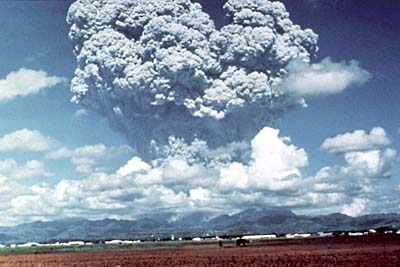
Mt. Pinatubo’s eruption in 1991 caused a volcanic cooling event. Image – USGS
Of the materials spewed out by volcanoes, chemical compounds that contain the element sulfur play the largest role in affecting the planet’s climate. To be specific, when sulfur-rich compounds, are blasted into the stratosphere (the layer above the troposphere, which is what’s directly over us) they will, over a timescale of months, react with water vapor to form sulfur aerosols. These form a whitish haze high up in the sky. These chemicals, now mostly sulfuric acid droplets increase the albedo or reflectivity of the planet and as a result, act to lower the overall incoming energy from the sun. Less energy coming into the planet, ultimately, less heat.
The actual chemistry behind sulfur dioxide combining with atmospheric oxygen and then water in the atmosphere looks something like this:
SO2 —> SO3 —> H2SO4
Sulfur dioxide is more effective than ash or other particulate matter from volcanoes in blocking sunlight since all but the smallest particles of ash will fall out of the sky eventually. Sulfuric aerosols can remain in the stratosphere for months or even – if enough volume gets blasted into the sky by the volcano – years. During these years, the droplets can spread to cover the entire earth, causing a global cooling effect, or can develop in a heavier concentration over a region, resulting in a more localized cooling effect. Eventually, under the right conditions, the droplets collect enough water and become heavy enough that they fall back to the surface.
Just to be clear – volcanoes aren’t the only things pumping sulfur dioxide into the atmosphere, humans do it too, thanks to inefficient burning of fossil fuels and the smelting of metal ores to produce aluminum, copper, zinc, lead, and iron. But two things about human-produced sulfur dioxide – though it can have limited climatological effects: 1) it doesn’t go as high as that coming from volcanoes, and 2) volcanoes produce a lot – a lot – more than we do.
As a result of not getting up into the stratosphere, human-created sulfur aerosols can be washed out of the atmosphere by rain (rain happens below the stratosphere), and contribute to acid rain on the surface. The day-to-day fluctuations in atmospheric sulfur dioxide concentration are all us, not volcanoes.
Case in point for the volcano side of this – the 1991 eruption of Mount Pinatubo in the Philippines. That eruption pushed more than 20 million tons of sulfur dioxide into the stratosphere. As expected – and predicted by climatologists – the SO2 formed sulfate aerosols which remained in the upper atmosphere for years. As a result of their presence, the earth’s average temperature dipped by about 0.6°C for roughly two years following the eruption.
On earth, large, climate-altering eruptions such as Pinatubo happen about every decade or so, although we haven’t seen anything on the scale of Pinatubo since its eruption, and certainly nothing like a Tambora or a Krakatoa before it anytime this century. Even North America’s own eruption of Mount St. Helens in 1980 only put 1.5 million tons of sulfur dioxide into the atmosphere, causing only negligible climate change.
But it is a mechanism which, given a strong enough volcano, or continued, strong eruptions could have an overall, cooling effect on the planet.
Geoengineering 101: Man-Made
So the idea then turns into “if volcanoes can do it, why can’t we?” Okay, there’s a whole lot wrong with that line of reasoning, but let’s put that to the side for a minute.
The idea to mimic what volcanoes do and load up the stratosphere with sulfur dioxide is an actual thing. An actual science thing.
Fifteen or twenty years ago, the idea of purposely injecting reflective chemicals into the stratosphere was fringe science, but the idea has been moving more towards the mainstream. Small scale, some researchers suggest dumping a load of sulfur-containing compounds over the Arctic, for instance, and watch the sea ice reform and the Greenland ice sheet stop melting and flowing into the ocean. Larger scale, find the right altitude, and just go for it – dump as much as we can, and bring the average temperature of the planet down.
But there are three words that are baked into this whole idea: we don’t know. Yes, sulfur dioxide, when shot into the stratosphere by volcanoes has a cooling effect on the earth. That’s a natural thing. When we do it…maybe there won’t be unintended consequences?
Hello, Snowpiercer.
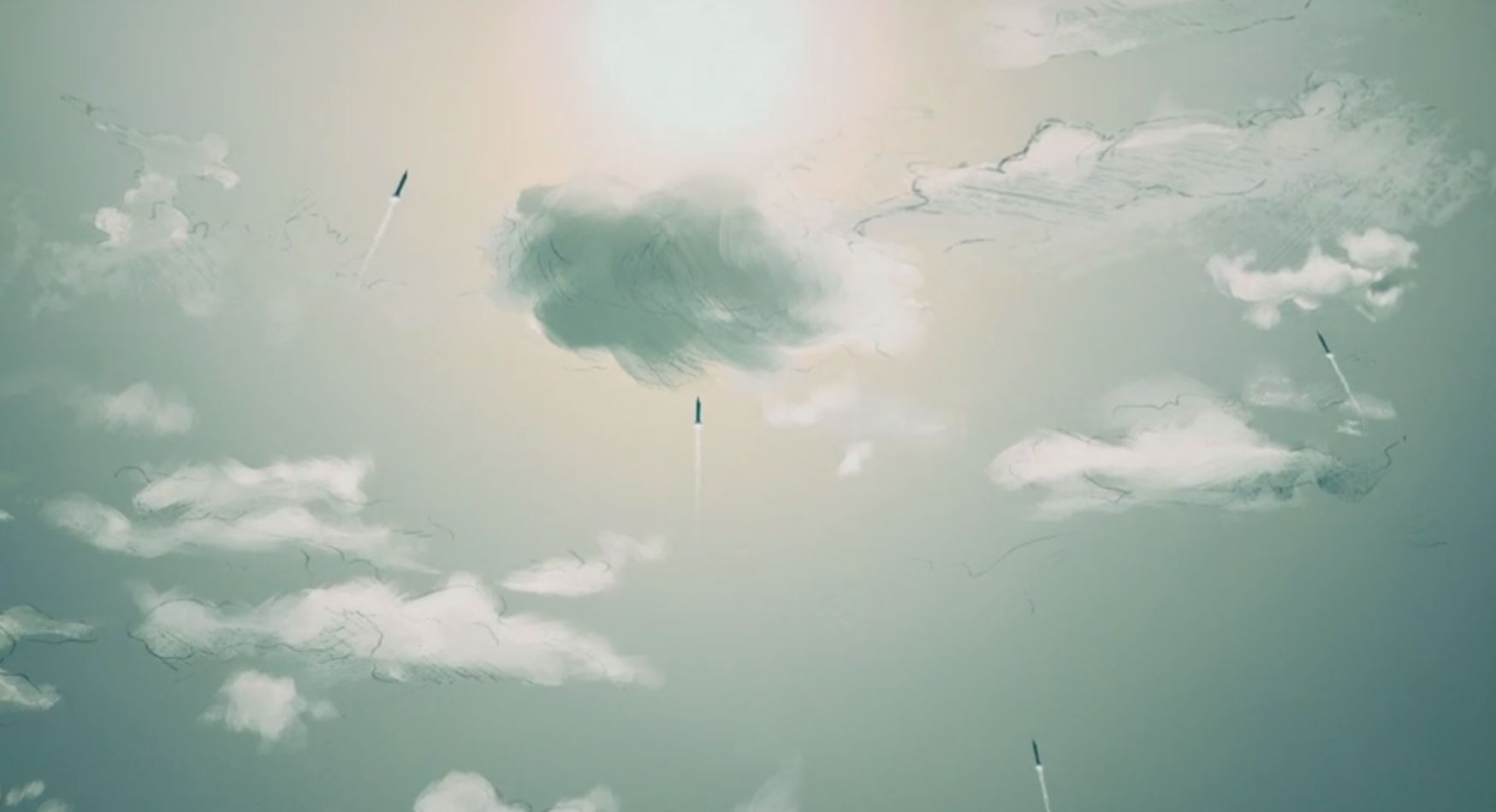
The rockets carrying their aerosol loads, from the opening of Snowpiercer’s first episode. (c) TNT
By putting sulfur dioxide into the upper atmosphere, we’re playing with a complex and dynamic system that even today, our most powerful computers can barely simulate – or keep up with. Case in point – Pinatubo’s eruption appeared to have some kind of effect on the ozone layer, which we just got done fixing through the entire planet working together for the greater good (although China has fallen off the wagon, apparently). Also – cool the planet, and precipitation decreases. That would need to be balanced – or somehow accounted for.
Not to mention, if we start…when do we stop? Do we call the plan off midway through if another ruling party comes to power in the lead country, a party based on the idea that stratospheric sulfur aerosols are bad? Also – injecting sulfur aerosols into the atmosphere increase the albedo of the planet, making it more mirror-like, and reflecting more of the sun’s energy. It does nothing to lower the problem the got us here in the first place: a steady, and ultimately massive increase in atmospheric carbon dioxide over the past 170 years.
Those suggesting this type of albedo-increasing geoengineering are upfront about this: it’s just a bandage to buy us time. Combined with efforts to reduce carbon emissions and actively pull carbon dioxide from the atmosphere, injecting aerosols could work. Without the efforts to reduce the atmospheric carbon dioxide, you’re setting the planet up for disaster.
We’ll talk more about this in a little bit.
But taking the cautious, measured approach isn’t what happened in Snowpiercer was it? Apparently, they just went for it.
And overdid it.
A Snowball Earth – Real or Nah?
The world as shown in Snowpiercer is a snowball. While the train’s path, as quickly shown in the opening credits remains exclusively on land, with the temperature at the quoted -119.6 degrees Celsius, the surfaces of the ocean would be completely frozen, too. Mr. Wilford apparently didn’t build tracks on water, or trans-oceanic bridges while he was setting up his escape plan (which meant he saw it as not being forever…which is important).
Yeah, so it’s cold. Really cold. Again, with earth as a snowball.
I’m not trying to be clever with the name. “snowball earth” is a legitimate hypothesis that suggests earth, throughout its history, has been frozen solid on more than one occasion. The term was coined by Joseph Kirschvink in 1992, with evidence and proponents/converts for, of and to the idea growing since then.
According to the hypothesis, “snowball earth” happens due to some triggering cooling event which results in an increase of snow and ice. In ancient times, this effect was accentuated by the continents being in different places than they are now, more clustered around the equator. When continents are spread more towards the poles, as they are now, more carbon dioxide can accumulate in the atmosphere, mediating a deep freeze thanks to the greenhouse effect. Push those continents back towards the equator, as they were millions of years ago, and you’ve got conditions that could tip into the deep freeze.
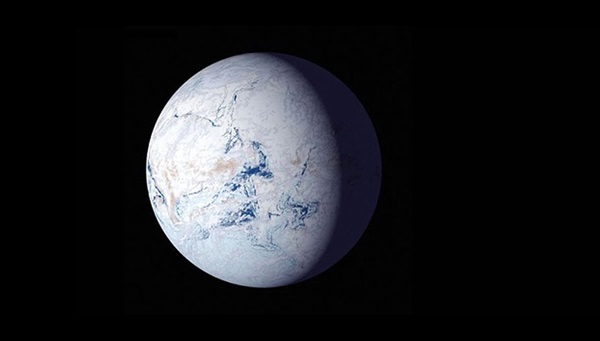
An artistic depiction of snowball earth.
There’s a lot to catch up on with the snowball earth hypothesis, and while I’m not able to fully cover it here, please dig into some further resources for more. But the basics of the larger hypothesis go like this:
-
- A triggering event. This can come from torrential rains that decrease carbon dioxide and other greenhouse gasses from the atmosphere, lowering the temperature; a change in earth’s orbit; a change in the sun’s output, or even a supervolcano pushing lots of sulfate particulates into the stratosphere. In short – global temperatures start falling for a reason. As a result, ice packs form at the poles and expand towards the equator. As one view of the theory suggests, once the ice has spread past 30 degrees north and south latitude, the earth’s albedo has increased enough to turn on a positive ice-albedo feedback loop of: less energy from the sun -> more cooling -> more ice formation -> albedo increases – less energy from the sun…and on and on. Under natural conditions – it would take about a thousand years to reach “snowball” status.
- Settling in. At -50 degrees Celsius, the oceans would freeze about a kilometer thick (which makes me think that Snowpiercer’s -119.6 Celsius is a mistake given its extreme overkill). Eventually, all of the water vapor would have come out of the air and been frozen on the ground, limiting the size of glaciers that now cover the bulk of the earth. There would be no rainfall in this dry, frozen desert world, no means to naturally scrub carbon dioxide out of the atmosphere, so what’s in the air will stay in the air. This is the situation for millennia.
- Continuing on. Over the course of the thousands of years of snowball earth, volcanoes will continue to erupt, both big and small. While the large eruptions will spew out literal tons more of sun-blocking sulfates, they’ll also pump out tons of carbon dioxide into the atmosphere. Continual small eruptions will do their bit for carbon dioxide as well. As for life – don’t worry. Melt pools would exist near volcanoes, the majority of the depth of the ocean would still be water (like an Enceladus of Saturn or Jupiter’s Europa), and near the places on the ocean floor where the seafloor is spreading, extremophiles – organisms which can exist based on chemosynthesis, rather than photosynthesis will also help keep the spark going. After all, there’s no complex life on the surface – maybe just some more extremophiles, such as the bacteria and tardigrades that can survive the conditions in Antarctica.
- A slow thaw. Slowly – slowly over thousands of years, and thanks to volcanoes and other seeps with gasses leaking out, the carbon dioxide on snowball earth will rise to a level that it will win the battle against earth’s high albedo, and start holding enough heat in to start warming the planet. How much would that be? An estimate from 1992 projected to warm up from a snowball, the earth would need 350 times that then-current amount of carbon dioxide in the atmosphere.
- The thaw continues. As temperatures continue to rise, ice will both sublimate (turn from a solid into a gas) and melt, putting a lot of water vapor into the atmosphere, helping to hold in more heat. The water vapor will ultimately refreeze at the poles, helping glaciers form, but slowly. The iced oceans will continue to melt, the darker-colored water absorbing more heat from the sun than the white ice that was once on top of it. The atmosphere continues to heat, and earth shoots through a slush world into a very hot, very humid world.
- After snowball. For how the earth looks after being a snowball, just think of the atmosphere – high concentrations of carbon dioxide and water vapor, holding in heat. Temperatures on earth would have soared following the thaw, with torrential rains eventually scrubbing some of the carbon dioxide out of the atmosphere by forming carbonic acid:
H2O + CO2 -> H2CO3 (carbonic acid)
The carbonic acid erodes the rocks left behind from the retreat of the glaciers (a lot of it, limestone, or calcium carbonate CaCO3). The resultant carbonate sediments flow into the sea and settle on the bottom, locking the carbon dioxide away from the atmosphere.
It’s this last bit that has given a lot of credence to the snowball earth hypothesis – layers have been found which show glacial deposits (material pushed by glaciers as they advanced) topped by carbonate sediments (from a hypothetical thaw), suggesting a dramatic temperature change from glacial to tropical. The cycle explained above fits the observation well.
Oh, and if you were worried about life – with the thaw, life forms would expand into all of the brand new niches and habitats and start kicking the respective tires to see if they could be successful. Much of the multicellular life we have today owe their existence to those snowball survivors.
There are disputes with the larger snowball earth theory, make no mistake – some critics point out that the amount of carbon dioxide needed to melt a completely glacial earth would have been unreasonably large, or that the evidence could have alternate interpretations, or no complete glaciation is needed to explain what the theory’s advocates are citing as evidence.
Where’s Snowpiercer in All of This?
Okay – I get it. No one should never look at Snowpiercer as an accurate educational resource…although it does have its moments. On the whole, science was never meant to ride in a first-class car in the story…it was always supposed to be the setup and then move to the background, and there are good reasons for that as we’ll get to in a minute. But as I said at the start, Snowpiercer serves as many things…and we can look at some science to see how it delivers as a warning.
When we join Snowpiercer, it’s seven years after the train departs from Chicago, which means it’s…perhaps 20 years after the rockets with the particulates went up into the stratosphere? After all, Mr. Wilford didn’t build have the Snowpiercer at the ready or build its track overnight. And Mr. Wilford wouldn’t have had to build it until he realized things were going way, way wrong, a few months to years after the rockets went up.
Speculation Part One – that all works unless Mr. Wilford is a monster, and knew how bad things were going to get ahead of time, and committed the largest act of genocide since Noah, taking the population down to 3,000 people. Okay – that’s a possibility, but still – the whole series is built on a foundation that something has gone wrong, not that this is all part of some master – albeit evil – plan. So far. Speculation Part Two – the world may be in the start of a thaw, given that every few episodes, there’s a danger to the track due to an avalanche or other outside disturbance. I’m not sold on that being caused by a thaw though – tectonic plates will still be active, and if the world is starting to thaw, then the -119.7 degrees Celsius temperature means that it’s been even colder. “Even colder” would suggest total ocean freeze, which would push that freeze past 30 degrees Nort and South latitude, and…inescapable snowball earth. So – maybe the earth is starting to thaw, but after at least seven years at colder-than-Europa temps…eeesh.
I’d call it at the survivors being roughly 20 years after the geoengineering rockets went up. Going back to the given, specific temperature of -119.7 Celsius, the ice on the ocean surface is at least a kilometer thick.
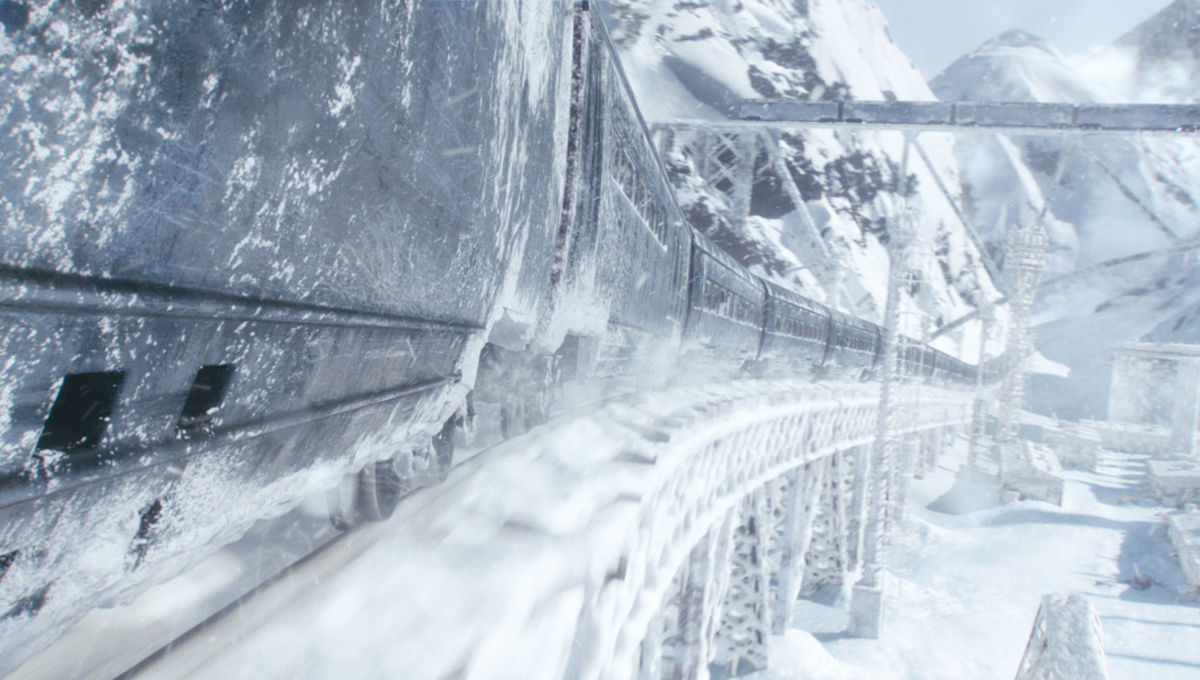
Snowpiercer’s -119.6 degrees Celsius world. (c) TNT
One of the interesting speculations we can make about the world is that leading to Snowpiercer’s departure is that it…sucked. Not sucked, but suuuuuuucked.
Don’t get me wrong – the first little bit would have been lovely – a return from the hot earth of the exposition to cooler global temperatures would’ve felt like things were working. But then…the first of the unexpected consequences would’ve settled in.
Let’s pull back from Snowpiercer’s world and over to ours just for a moment. According to a study published in Geophysical Research Letters by Charles Gertler and his colleagues, modeling of limited geoengineering via stratospheric injection, the approach could weaken the tracks of extratropical (middle and high latitudes) storms.
The model projected the effect of the blockage of enough solar radiation to offset the heating caused by a level of carbon dioxide that’s quadruple present-day atmospheric concentrations. In the models, the research team saw weakened tracks that could lead to both weaker storms, but also to stagnant air conditions, which, in the summer, could result in increased air pollution without windy conditions that would blow the pollution away.
In short, the researchers stated: “Climate under solar geoengineering would nonetheless be meaningfully different from a baseline climate without increased carbon dioxide,” adding that rather than being a pause button on climate change, geoengineering could introduce novel climate changes.
The research wasn’t the only criticism of geoengineering that predicted bad times after using the method, it was just the latest. Other research and articles suggest:
- Dangerous consequences for biodiversity
- The difficulty of stopping geoengineering
- 20 reasons why geoengineering may be a bad idea
- Geoengineering is not a solution to climate change
- World needs to set limits for geoengineering experiments, experts say
But with the litany of warnings and scientific wariness that are attached to geoengineering, there is an inexorable slow crawl towards it.
- 3 huge geoengineering projects are underway to save the planet
- US geoengineering research gets a lift with $4 million from Congress
- Mission-driven research for stratospheric aerosol geoengineering
In all fairness, not every “geoengineering” mention is exclusively about aerosols in the stratosphere. Some include other solar reflectors, adding iron to oceans to cause a phytoplankton bloom and other methods, but aerosols always have a place at the geoengineering table.
Alright – back to Snowpiercer’s world. The aerosol didn’t come down or at least didn’t come down as quickly as hoped.
Clearly, unexpected consequences (notwithstanding Mr. Winford being a monster and causing all of this…) rule the day in Snowpiercer. Aerosol-induced climate changes and reduced incoming solar radiation most likely led to changes in weather systems, changing rain and snowfall patterns and amounts, which would have led to droughts, food shortages, and instability, which are always touchpoints for migration, treating people badly, and ultimately, wars. That would’ve sucked.
Oh, and nothing against Mr. Wilford and his visionary ways, but he wouldn’t have been the only person seeing this disaster on the horizon. Famers would’ve seen it coming – smaller crop yields each progressive season. Climate scientists would have pointed out that the nights were growing colder and the winters were growing longer as the world cooled. Oceanographers would’ve pointed out that the ocean was becoming more acidic than ever (carbon dioxide was not coming down) and fisheries were in danger or, or in the process of collapsing. Astronomers would have caught that the sunlight was dimmer. Atmospheric scientists would have been screaming about how messed up the atmosphere was. Stop me if this is all sounding too familiar – but in the world of Snowpiercer, at least, the Big Freeze was clearly on the way.
When do you think they realized they were screwed? LIke no-coming-back screwed? What would that world have been like?
Speaking of the sun, solar panels would’ve seen lower efficiency during this time, and that’s important, especially if you add in the possibility of an altered climate with stagnant air masses that wouldn’t turn wind generators as much. Energy from renewables would’ve decreased. What then? Burn more oil. Burn more wood. Burn more biomass. Release more carbon dioxide into the atmosphere. Who cares, right? Climate change is fixed, yeah?
Yeah, but it’s not. As mentioned earlier, stratospheric aerosols are just a bandage on the wound, not a means to heal the wound. Injecting reflective aerosols into the stratosphere should be a temporary measure, something you do while you work as hard as you can to remove the carbon dioxide from the atmosphere. That way, when the aerosols finally come down with precipitation, the carbon levels in the atmosphere aren’t as bad as they were. It’s what we should do if we ever get serious about this approach.
But – to continue to speculate on the lead-up to what happened in Snowpiercer’s world before we joined the train in episode 1…if all the models say the planet is cooling too fast and too much – why would you want to take any carbon dioxide out of the atmosphere at all? After all, that might just heat up the planet again. Going out on a bit of a limb – I would argue that any carbon-capture efforts that were started after the aerosols went up ended not-too-long after.
And that ice was creeping down from the poles. Using the critical latitude aspect of the snowball earth hypothesis as a possible method by which the world ended up the way it did…once that ice crossed the 30-degree line, both north, and south, it wouldn’t have mattered if the aerosols came down out of the sky. The trigger had been pulled. Oops. The idea that Snowpiercer’s world was pushed into snowball earth is backed up by images from the series that show the train speeding along on top of an endless snowfield, under a crystal-clear blue sky, that is, one without a haze of particulate reducing the incoming solar energy. Yeah, oops.
Following that line of thought – and I have no idea if that’s where the story is going, the survivors on the Snowpiercer really don’t matter then. Their whole story is the band playing on the Titanic. The train, their stuff, and their desiccated bodies will make some interesting discoveries for whatever species has archeologists a few hundred million years in the future of that world. There’s no way they can live through this.
Okay – that’s probably not where things will go – the graphic novel series and even the movie hinted at survival after the train…somehow. Maybe.
But even if they get out…there’s no happy ending. The earth would take decades to warm up again – during which all-new larger climate and local weather systems would be an absolute nightmare of Biblical floods and storms, atmospheric carbon dioxide would still be sky-high (maybe reduced due a little due to the torrential rains), virtually all plant and animal food sources are long-extinct, and they have very, very limited technology (the “perpetual motion engine” which powers the train is only capable of putting out a set amount of power…), and from what the series has shown, the train isn’t full of people you’d want to help out when you’re digging your way out of an armageddon.
But that’s the bigger message, isn’t it?
We – and the people on the Snowpiercer, are at the mercy of the systems of our planet. Sure, they’re on a luxury train, and we’re still living life quasi-normally, but we’re the same: we’re all on borrowed time. The planet right now is responding – just like the earth of Snowpiercer – it’s responding to what we’ve done, and continue to do to it.
If we can’t set things right…the planet’s not going to kill us. The earth is just going to be the earth. It will have been our actions that killed us.


